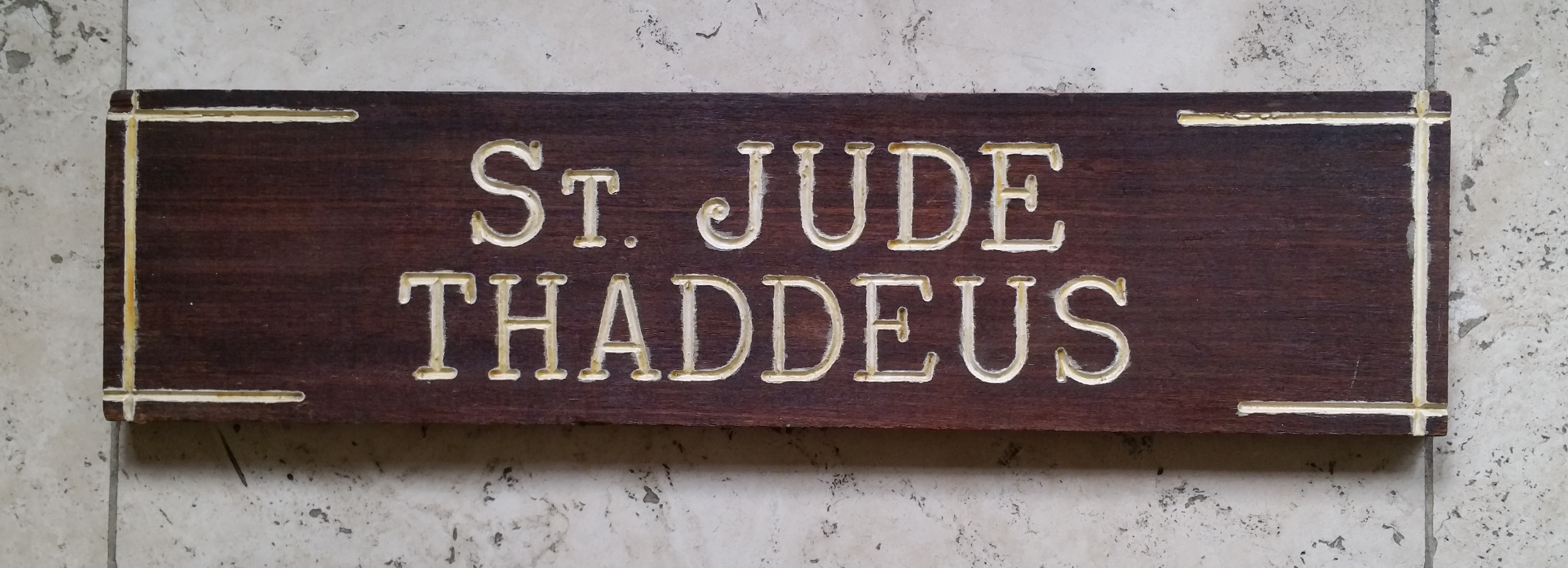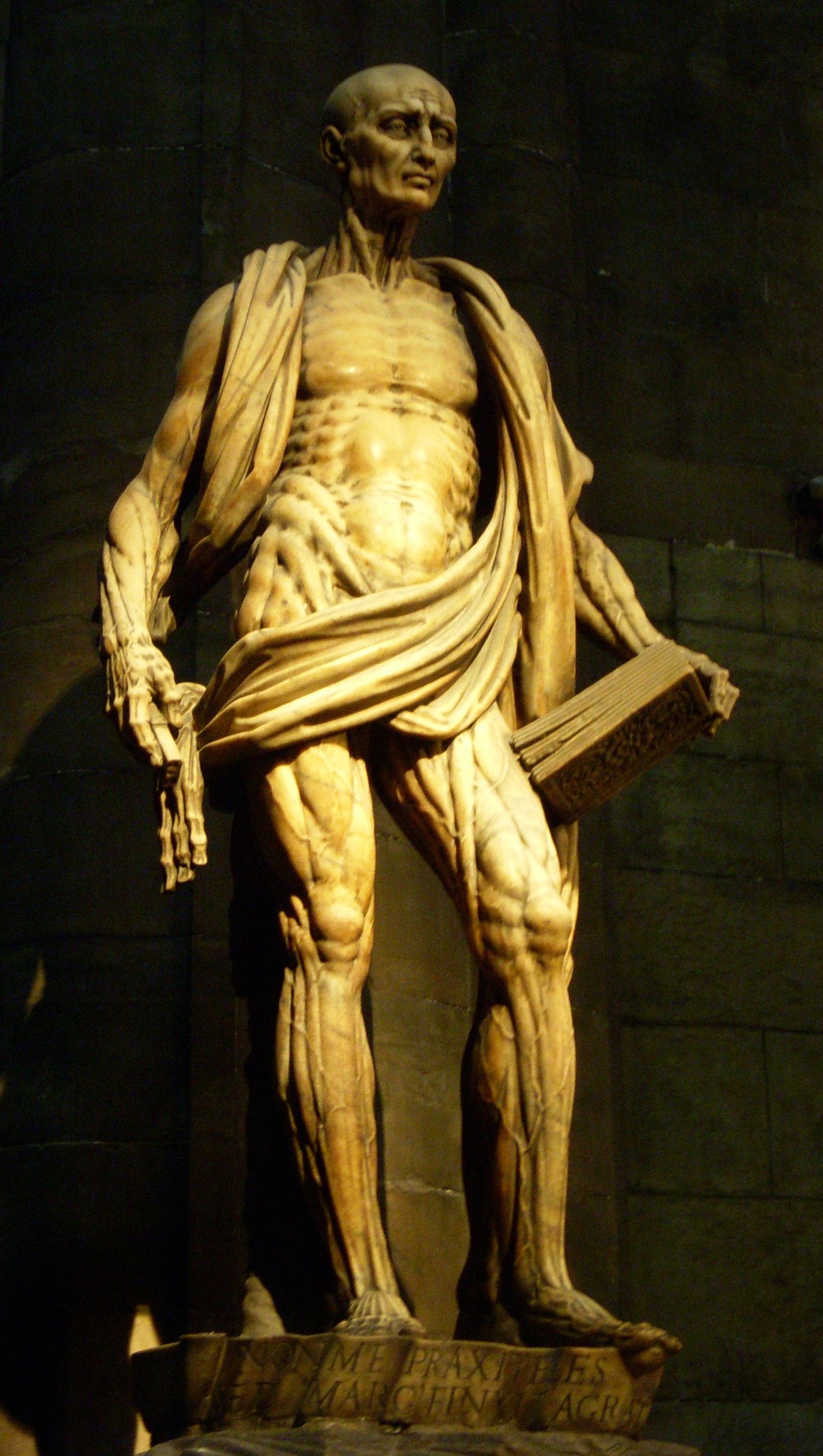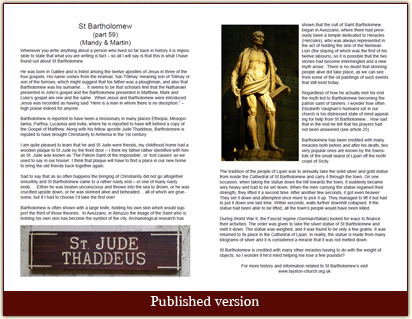Martin & Mandy
Whenever you write anything about a person who lived so far back in history it is impossible to state that what you are writing is fact – so all I will say is that this is what I have found out about St Bartholomew.
He was born in Galilee and is listed among the twelve apostles of Jesus in three of the four gospels. His name comes from the Aramaic 'bar-Tôlmay' meaning son of Tolmay or son of the furrows, which might suggest that his father was a ploughman, and also that Bartholomew was his surname.... It seems to be that scholars feel that the Nathanael presented in John's gospel and the Bartholomew presented in Matthew, Mark and Luke's gospel are one and the same. When Jesus and Bartholomew were introduced Jesus was recorded as having said "Here is a man in whom there is no deception." – high praise indeed for anyone.
Bartholomew is reported to have been a missionary in many places Ethiopia, Mesopotamia, Parthia, Lycaonia and India, where he is reported to have left behind a copy of the Gospel of Matthew. Along with his fellow apostle Jude Thaddeus, Bartholomew is reputed to have brought Christianity to Armenia in the 1st century.
I am quite pleased to learn that he and St Jude were friends, my childhood home had a wooden plaque to St Jude by the front door – I think my father rather identified with him as St. Jude was known as 'The Patron Saint of the Impossible', or 'lost causes' as we used to say in our house! I think that plaque will have to find a place in our new home to bring the old friends back together again.

Sad to say that as so often happens the bringing of Christianity did not go altogether smoothly and St Bartholomew came to a rather nasty end – or one of many nasty ends… Either he was beaten unconscious and thrown into the sea to drown, or he was crucified upside down, or he was skinned alive and beheaded… all of which are gruesome, but if I had to choose I'd take the first one!

Bartholomew is often shown with a large knife, holding his own skin which would support the third of those theories. In Avezzano, in Abruzzo the image of the Saint who is holding his own skin has become the symbol of the city. Archaeological research has shown that the cult of Saint Bartholomew began in Avezzano, where there had previously been a temple dedicated to Heracles (Hercules), who was always represented in the act of holding the skin of the Nemean Lion (the slaying of which was the first of his twelve labours), so it is possible that the two stories had become intermingled and a new myth arose. There is no doubt that skinning people alive did take place, as we can see from some of the oil paintings of such events that still exist today.
Regardless of how he actually met his end the myth led to Bartholomew becoming the patron saint of tanners. I wonder how often Elizabeth Vaughan's husband sat in our church is his distressed state of mind appealing for help from St Bartholomew... How sad that in the end he felt that his prayers had not been answered (see article 25)
Bartholomew has been credited with many miracles both before and after his death, two very popular ones are known by the townsfolk of the small island of Lipari off the north coast of Sicily.
The tradition of the people of Lipari was to annually take the solid silver and gold statue from inside the Cathedral of St Bartholomew and carry it through the town. On one occasion, when taking the statue down the hill towards the town, it suddenly became very heavy and had to be set down. When the men carrying the statue regained their strength, they lifted it a second time. After another few seconds, it got even heavier. They set it down and attempted once more to pick it up. They managed to lift it but had to put it down one last time. Within seconds, walls further downhill collapsed. If the statue had been able to be lifted, all the town's people would have been killed.
During World War II, the Fascist regime (German/Italian) looked for ways to finance their activities. The order was given to take the silver statue of St Bartholomew and melt it down. The statue was weighed, and it was found to be only a few grams. It was returned to its place in the Cathedral of Lipari. In reality, the statue is made from many kilograms of silver and it is considered a miracle that it was not melted down.
St Bartholomew is credited with many other miracles having to do with the weight of objects, so I wonder if he'd mind helping me lose a few pounds!?
For more history and information related to St Bartholomew's visit www.layston-church.org.uk or follow us on Twitter @layston_herts

 |
|
 |

